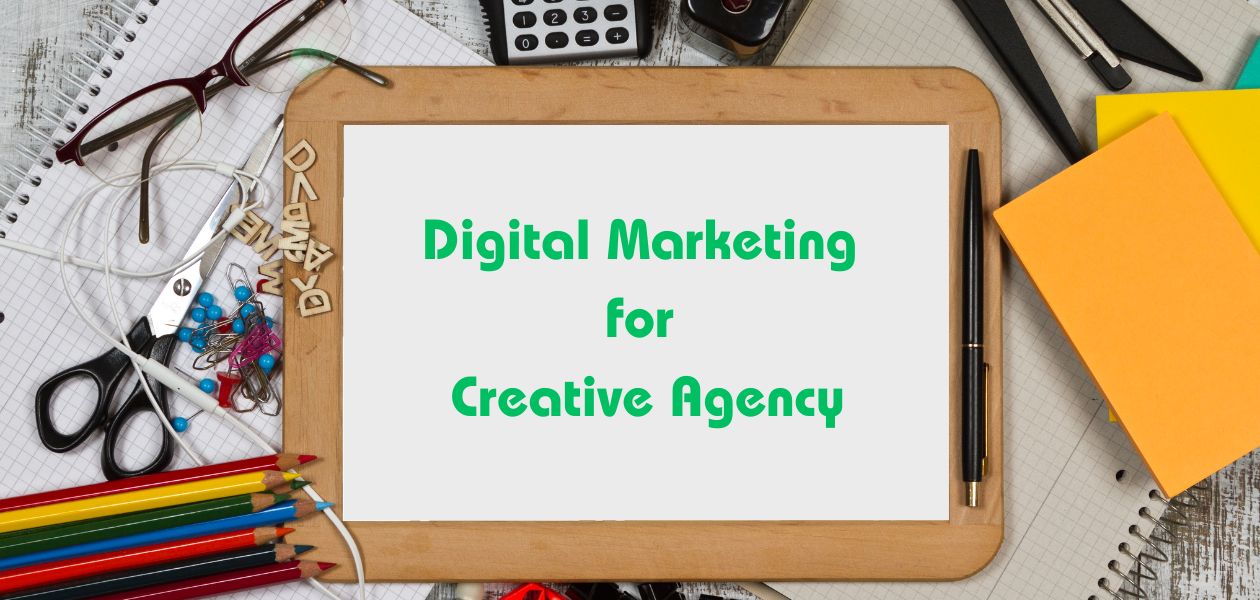Marketing for Creative Agencies
Digital Marketing for Creative Industries
For creative agencies and individuals working in the creative industries, including animation studios, production companies, illustrators, and artists, digital marketing services are essential to their success and growth.
Being well-known online and successfully reaching your target demographics are crucial in today’s digital world. These strategies allow creative businesses and individuals to present their work, increase brand recognition, draw in new customers, and meaningfully interact with their audience.
The advantages of using digital marketing techniques for creative agencies:
For creative businesses, such as animation studios, production companies, illustrators, and artists, utilizing Internet marketing methods has several advantages. Several advantages are listed below:

Conventional Marketing Channels:
When compared to conventional advertising channels, it offers cost-effective promotional strategies. Creative agencies can connect with their target audience without incurring the significant expenses associated with conventional marketing channels by creating and distributing content on social media platforms, optimizing websites for search engines, and executing focused advertising campaigns.
Targeted Audience Engagement:
Brand Building and Awareness:
Data-Driven Insights:
Measurable Results and Return on Investment (ROI):
How can you sell expert services using digital marketing?
For creative agencies and artists, mastering digital marketing: From Sketch to Success

The first is SEO (search engine optimization):
By utilizing efficient SEO techniques, design firms, animation studios, production companies, illustration studios, and artists may boost their online visibility and attract targeted organic traffic. This entails optimizing their websites with focused keywords, creating relevant and high-quality content that aligns with their areas of expertise and services, and improving technical aspects like website structure, page load time, and mobile friendliness.
Additionally, acquiring high-quality backlinks from reliable websites and utilizing local SEO tactics may help businesses rank higher in search engine results, enhancing their chances of being seen by potential customers seeking creative services. A strong SEO presence enables creative agencies to showcase their distinctive skills and offers to a wider audience, increasing organic traffic and solidifying their position as thought leaders in their field.
Pay-Per-Click (PPC) Advertising:
Creative agencies, animation studios, production companies, illustrators, and artists are able to publish adverts across search engines and different internet channels thanks to tailored PPC campaigns. They may attract highly targeted visitors to their websites and landing pages by carefully choosing pertinent keywords, identifying their target audience, and creating attractive ad text. Spending may be optimized and budgets can be set with the ability to track campaign results in real-time.
Furthermore, PPC advertising increases the likelihood of producing high-quality leads and conversions by allowing creative agencies to specifically target their potential clientele while they are actively looking for comparable services. Creative companies may boost their exposure, grow their clientele, and accomplish their business objectives in a cost-effective and measurable manner with the help of clever PPC campaigns.
Content Marketing:
Creative agencies, animation studios, production houses, illustrators, and artists can establish themselves as thought leaders and experts in their respective creative fields by creating and sharing valuable, informative, and compelling content such as blog posts, articles, videos, infographics, and case studies.
Content marketing enables them to demonstrate their expertise, share insights, and give educational tools relevant to their target audience. This strategy not only attracts new clients but also fosters trust, credibility, and loyalty among existing ones.
Social Media Marketing:
Using major social media sites such as Facebook, Instagram, Twitter, LinkedIn, and YouTube, creative enterprises, animation studios, production houses, illustrators, and artists may exhibit their work, engage with followers, and attract potential clients. Social media marketing allows them to give visually engaging content such as artwork, animations, behind-the-scenes films, and project highlights to attract and excite their audience.
It also enables direct engagement, allowing creative people to respond to comments, answer inquiries, and build relationships with their audience. Through strategic content creation, continuous posting, and targeted advertising, social media marketing helps to increase brand visibility, drive website traffic, foster community interaction, and finally deliver leads and conversions. Furthermore, social media analytics provide valuable insights for improving and refining marketing activities.
Email Marketing:
Creative firms, animation studios, production houses, illustrators, and artists may directly engage with their clients, prospects, and followers by creating an email subscriber list and providing personalized and targeted communications. Email marketing enables artists to share updates, announce new projects, give exclusive promotions, and provide useful information such as newsletters, tutorials, and industry insights.
They may exhibit their creative work and urge recipients to do desired actions, such as visiting their website, making a purchase, or hiring their services, using well-designed email templates and appealing language. Furthermore, email marketing automation systems allow for the scheduling of email campaigns, audience segmentation based on interests and behaviors, and campaign effectiveness analysis using metrics such as open rates, click-through rates, and conversions.
Email marketing can help them generate brand loyalty, promote repeat business, and establish themselves as trusted authorities.
Online Reputation Management:
To preserve a favorable reputation and gain the trust of their audience, advertising firms, animation studios, production companies, illustrators, and artists must effectively manage their online reputations. It entails keeping an eye on, influencing, and sculpting how their brand or personal reputation is seen online. Using the following techniques will help you manage your internet reputation:
- Monitoring: Consistently keeping an eye on internet resources including social media, forums, review sites, and search engine outcomes to stay informed of any comments, critiques, or discussions pertaining to the company or specific person.
- Reacting: Quickly reacting to client evaluations, comments, and questions, whether they are favorable or unfavorable, in order to demonstrate an engaged and attentive presence. Reputational harm can be reduced by responding to complaints and addressing issues in an open manner.
- Interacting with the audience: Regularly interacting with the audience via blog comments, social media interactions, and other online platforms to build rapport and show that you genuinely care about their wants and ideas.
- Content creation: Producing top-notch content, like articles, blog posts, videos, or cases, that highlights accomplishments, demonstrates expertise, and adds value for readers. In the creative sector, this establishes credibility and authority.
- Establishing a strong online presence: One way to increase credibility and improve one’s overall online reputation is to actively participate in debates pertaining to the sector, make contributions to pertinent online communities, and look for possibilities to work with other respectable businesses or influencers.
Creating a Digital Marketing Plan:
The creative industry’s creative firms, animation studios, production companies, illustrators, and artists all stand to gain greatly from developing a digital marketing plan. In a cutthroat digital environment, it allows them to effectively market their services, highlight their distinctive talents, and connect with their target audience.
A carefully planned digital marketing strategy aids in boosting brand awareness, luring in potential customers, and cultivating enduring partnerships. Creative agencies can increase their online presence, stand out from rivals, and ultimately contribute to business development by establishing relationships with clients who value and appreciate their creative work by utilizing various digital channels like social media, SEO, blogging, and email marketing.
Importance of Competitor Analysis for creative agencies:

Developing Insights:
Recognize your competitive landscape:
Performance benchmarking:
Discovering new opportunities:
Improving differentiation and positioning:
Importance of website optimization for Creative Agency:
A well-optimized website not only improves user experience but also increases exposure in search results, generating organic traffic and boosting conversion rates.
Creative agencies may successfully present their portfolio, services, and skills by optimizing website structure, enhancing load speed, applying responsive design, and optimizing metadata and keywords. In the cutthroat creative industries, a user-friendly and aesthetically pleasing website makes a good first impression, attracts visitors, and eventually generates more inquiries, clients, and business growth.
Improved User Experience:
By optimizing your website, you can guarantee that users will have a smooth and delightful time surfing. This entails enhancing site navigation, reducing page load times, and producing a design that is aesthetically pleasing. A good user experience promotes engagement, encourages service discovery, and raises conversion chances.
Increased Search Engine Visibility:
Higher Conversion Rates:
Mobile-Friendly Experience:
Competitive Advantage:
Data-Driven Decision-Making:
Content Marketing for Creative Agencies
Establishing skills:
Establishing Trust and Relationships:
Raising Brand Visibility and Awareness:
Driving Organic Traffic and SEO:
Displaying Your Creativity and Unique Viewpoint:
Choosing the right digital marketing channels

Identify the Main Goal for Creative Agency:
Understanding your major goal can help you choose the correct digital marketing platforms, whether you are an animation company, production business, illustrator, or artist. If you want to achieve thought leadership and authority, you must focus on insightful material and valuable blogging.
You may exhibit your knowledge and attract a target audience looking for important information by writing smart articles, tutorials, and industry updates. Furthermore, releasing this material across relevant channels such as social media, email marketing, and industry journals will broaden your reach and increase engagement.
You may effectively promote your creative work, enhance brand recognition, and build meaningful connections within the creative industries by aligning your digital marketing channels with your core purpose.
Select the Targeted Audience:
Understanding your prospective clients’ demographics, tastes, and online behavior will help you select the best digital marketing channels to efficiently reach and engage them. For example, if you cater to a younger audience, platforms like Instagram and TikTok may be great for visually exhibiting your creative work.
LinkedIn can be a helpful tool for establishing industry relationships and sharing informative content if your target audience consists of professionals and enterprises. By defining your target audience, you can adjust your digital marketing methods, such as educational content and value blogs, to their interests and needs, resulting in increased engagement, conversions, and business success in the creative industries.
Select the Correct Platform to Target the Audience and Achieve the Goal:
Because each platform has its own set of characteristics and user demographics, it’s critical to match your goals and target audience with the right platforms. For example, if you want to visually present your creative work, sites like Instagram or Behance can provide your audience with a visually appealing experience.
If your goal is to publish useful information and interesting articles, networks like LinkedIn or Medium can help you reach a more audience looking for industry insights.
You can maximize the impact of your digital marketing efforts, enhance brand awareness, and build meaningful connections within the creative industries by picking the right platform that connects with your target audience and coincides with your marketing goals.
Selecting the Right Social Media Platforms for Creative Agencies
Instagram and Pinterest, for example, provide possibilities to display your creative work, give behind-the-scenes information, and engage with a visually-minded audience. LinkedIn and Twitter can be useful sites for engaging with audiences and participating in relevant conversations if you want to exchange industry expertise and ideas.
Furthermore, platforms such as Facebook and YouTube can provide a greater reach and a variety of content formats to engage with a diverse range of audiences. You can effectively leverage social media to build brand awareness, connect with your target audience, and promote your creative services within the dynamic landscape of the creative industries by carefully selecting the right social media platforms that align with your brand, audience preferences, and marketing goals.
Building a Strong Online Presence and Brand Image:
An effective digital marketing plan enables you to build your distinct personality, demonstrate your inventiveness, and set yourself apart from the competition. You may regularly exhibit your work, communicate with your target audience, and convey your brand story by leveraging multiple online platforms such as social media, websites, and online portfolios.
Engaging material, such as instructive blogs, visually appealing photographs, and intriguing films, helps to leave a lasting impression and cultivates a loyal following. Consistency in language, graphic components, and interactions across digital media boosts your brand image and fosters trust among potential customers.
You may broaden your reach, attract new prospects, and establish your brand as a renowned and sought-after organization in the creative business by focusing on developing a strong online presence.
Paid Advertising for Creative Agencies:
Artists can strategically advertise their services, portfolios, and creative projects to a wider audience by investing in paid advertising channels such as search engine advertising (Google Ads), social media advertising (Facebook Ads, Instagram Ads), or display advertising.
You may target certain demographics, interests, and search queries with paid advertising, ensuring that your adverts are exposed to relevant users who are more likely to be interested in your products.
Paid advertising provides a scalable and measurable option to boost brand visibility, improve website traffic, and create leads in the competitive landscape of the creative industries, with the flexibility to set budgets, monitor performance metrics, and optimize campaigns in real time.
Email Marketing for Creative Agencies:
Building an email list of interested subscribers allows you to directly communicate with your audience, nurture relationships, and promote your services and creative endeavors. Email marketing allows you to provide personalized and targeted material to your subscribers’ inboxes, such as updates, newsletters, announcements, and exclusive offers.
It allows you to exhibit your most recent work, give industry insights, and provide helpful resources that your audience will appreciate. You may customize your communications to specific groups by segmenting your email list based on interests, demographics, or previous interactions, ensuring improved engagement and conversion rates.
Furthermore, email marketing provides essential analytics and tracking features, allowing you to analyze campaign efficacy and make data-driven enhancements.
FAQs:
How would digital marketing help my creative agency or business?
By improving brand visibility, reaching a bigger audience, generating leads, and driving conversions, digital marketing may greatly benefit creative agencies and enterprises in the creative industries.For my creative agency, which digital marketing channels should I prioritize?
Your choice of digital marketing channels is determined by your target audience and business objectives. However, social media platforms such as Instagram and Facebook are popular for promoting visual material. Content marketing, search engine optimization (SEO), email marketing, and paid advertising are also viable options to consider.How can I use digital marketing to effectively promote my creative services?
To promote your creative services, create intriguing material that highlights your portfolio, skills, and distinct style. Share your work on social media networks, interact with your audience, and connect with influencers. Optimize your website for search engines, run email marketing campaigns to nurture prospects, and take advantage of paid advertising.Is a blog required for my creative agency’s website?
While a blog is not required, it can be quite advantageous to your creative agency. A blog allows you to share insights, industry trends, tutorials, and behind-the-scenes anecdotes with your target audience, which helps establish your authority and engage them. It also contributes great content for SEO and brings organic traffic to your website.How can I strengthen my creative agency’s web presence?
Developing a great online presence necessitates consistent branding, engaging content, an active social media presence, search engine optimization, and the administration of a positive online reputation. By concentrating on these qualities, you can position your firm as a credible and sought-after creative entity in the digital space.